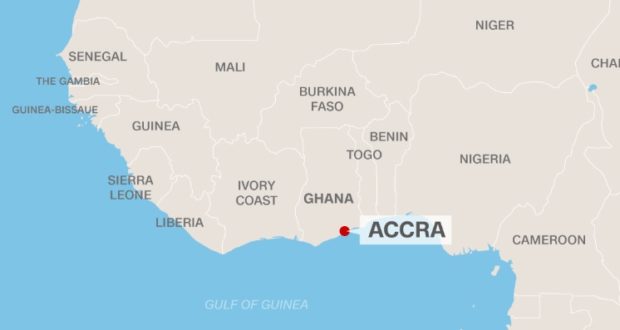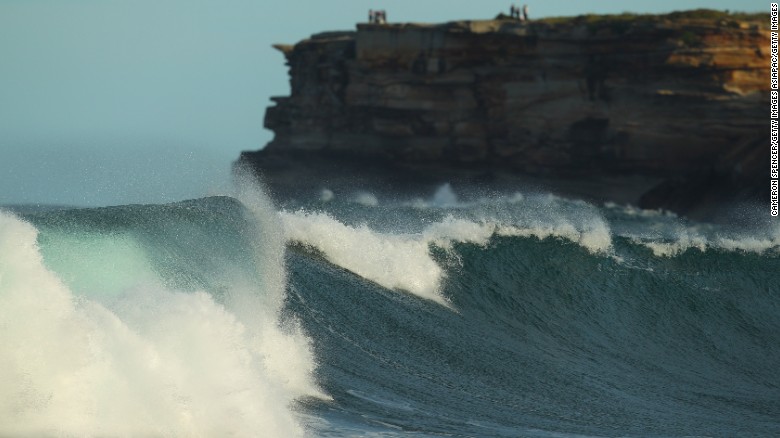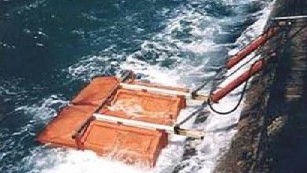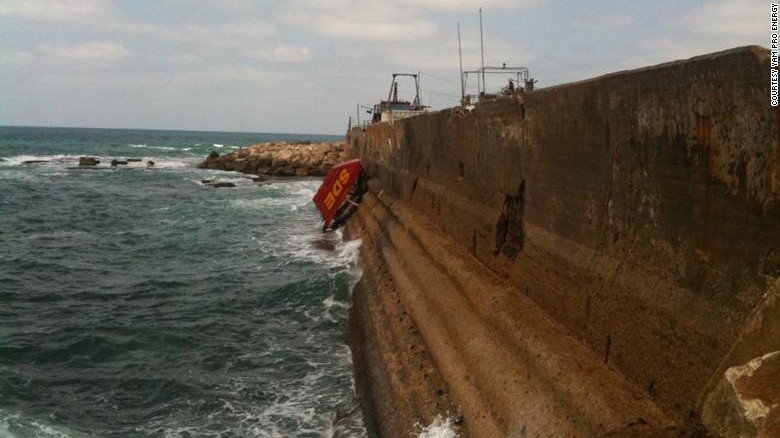Photos: The clean energy giants powering Africa
Hydropower sharing – Chinese construction companies are developing a record-breaking hydropower project in Nigeria that has been compared to the world’s largest hydropower plant the Three Gorges Dam (pictured) in Yichang, China.
Hide Caption
1 of 13

Photos: The clean energy giants powering Africa
Gibe III Hydroelectric Project, Ethiopia – Africa is scattered with impressive renewable energy megaprojects. Harvesting the power of the Omo River, approximately 300km south west of the capital Addis Ababa, Gibe III is one of the largest of its kind in Africa.
Hide Caption
2 of 13
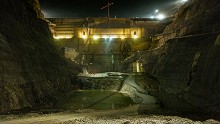
Photos: The clean energy giants powering Africa
Gibe III Hydroelectric Project, Ethiopia – The project has started producing energy and with all turbines switched on, it will have an outgoing power capacity of 1,870 megawatts — according to the Italian company, Salini Impregilo, which is building the dam on behalf of Ethiopian Electric Power.
Hide Caption
3 of 13
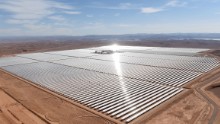
Photos: The clean energy giants powering Africa
Noor Complex Solar Power Plant, Morocco – The world’s largest concentrated solar power (CSP) plant, called the Noor Complex, is being built in the Moroccan desert. Noor 1, the first phase of three, is located near the town of Ouarzazate on the edge of the Sahara.
It was switched on in February, 2016, and provides 160 megawatts of the project’s planned 580 megawatt capacity. Once completed in 2018, the project is expected to provide electricity for 1.1 million people.
It was switched on in February, 2016, and provides 160 megawatts of the project’s planned 580 megawatt capacity. Once completed in 2018, the project is expected to provide electricity for 1.1 million people.
Hide Caption
4 of 13
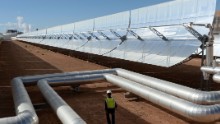
Photos: The clean energy giants powering Africa
Noor Complex Solar Power Plant, Morocco – Morocco has committed to increasing its share of renewable energy generation to 42% by 2020.
Hide Caption
5 of 13
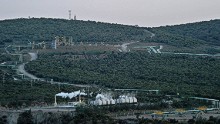
Photos: The clean energy giants powering Africa
Olkaria Geothermal Power Plant, Kenya – Several renewable power plants are operating in the geothermal fields of Olkaria, Kenya, harvesting the power of underground geothermal energy.
The site is located on the floor of the Kenyan Rift Valley, near the shores of Lake Naivasha some 120 kilometers north-east of the capital, Nairobi.
The site is located on the floor of the Kenyan Rift Valley, near the shores of Lake Naivasha some 120 kilometers north-east of the capital, Nairobi.
Hide Caption
6 of 13
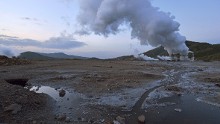
Photos: The clean energy giants powering Africa
Olkaria Geothermal Power Plant, Kenya – A recent expansion, Olkaria III, began commercial operations in 2015 and is expected to power over 250,000 households in Kenya, supporting the Government’s 2030 vision to increase generation capacity, according to the construction company, Ormat.
The Olkaria plant has a capacity of 280 megawatts and is connected to the nation’s grid. Geothermal power is big in Kenya, where it accounts for nearly half the country’s energy supply.
The Olkaria plant has a capacity of 280 megawatts and is connected to the nation’s grid. Geothermal power is big in Kenya, where it accounts for nearly half the country’s energy supply.
Hide Caption
7 of 13
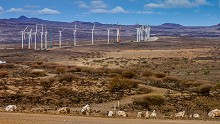
Photos: The clean energy giants powering Africa
Lake Turkana Wind Project, Kenya – The 310 MW Lake Turkana Wind Power Project, which is being developed in the country’s North-East, will cover 40,000 acres. The 70 billion Kenyan Shillings ($690 million) project is the largest private investment in Kenya’s history, according to the developers.
Hide Caption
8 of 13
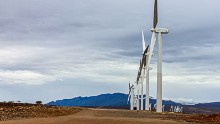
Photos: The clean energy giants powering Africa
Lake Turkana Wind Project, Kenya – At least 100 turbines are expected to be ready on site by September, 2016. On completion, the project will comprise 365 wind turbines, each with a capacity of 850 kilowatts, and will be connected to the national grid system. The company hopes to produce 18% of Kenya’s electricity generating capacity when it comes online.
Hide Caption
9 of 13
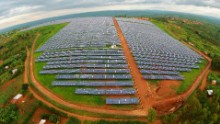
Photos: The clean energy giants powering Africa
The Rwanda Solar Power Field – An Africa-shaped 8.5 megawatt solar plant east of Rwanda’s capital Kigali came into full production in December 2015. Its 28,360 photovoltaic panels spread across 17 hectares and light up 15,000 homes in the region — boosting electricity generation in Rwanda by 6%.
Hide Caption
10 of 13
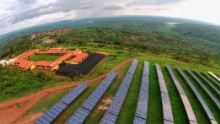
Photos: The clean energy giants powering Africa
The Rwanda Solar Power Field – The project was financed in collaboration with Power Africa, a transnational initiative launched in 2013 by U.S. President Obama with the aim of adding 30,000 megawatts of clean electricity to sub-Saharan Africa.
Hide Caption
11 of 13

Photos: The clean energy giants powering Africa
Ingula Pumped Storage Scheme, South Africa – The Ingula Hydroelectric Plant in South Africa has now begun production, and is the fourth of its kind to be built in the country. With some parts still under construction, it has a planned capacity of around 1,100 megawatts and will be one of the largest in terms of power generating capacity once fully operational, according to construction company Salini Impregilo.
Hide Caption
12 of 13
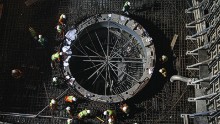
Photos: The clean energy giants powering Africa
Ingula Pumped Storage Scheme, South Africa – Located below the Little Drakensberg mountain range along the border of the KwaZulu-Natal and Free State provinces, the project stretches underground through a large tunnel network several kilometers long. It will generate and store power using turbines and pumps which recycle the water by pumping it back up to the reservoirs at night when the demand is low.
Hide Caption
13 of 13













Story highlights
- Israel-based company will build a wave energy power plant on Ghana’s coastline
- Energy can be harvested from the pressure of crashing waves
(CNN)The force of crashing waves can generate huge amounts of energy.
But there’s a catch: how do you develop technology that can withstand the sea’s harsh environment with minimum disruption to the ecosystem?
One Israeli-based company, Yam Pro Energy — believes it can offer the ideal solution and is set to build a wave-energy plant on the coastline of Accra, Ghana’s capital city.
Wave technology is an endeavor that has recently been trying to catch up with the likes of solar and wind energy.
It exploits a resource — the oceans — that covers 71 per cent of our planet, it’s environmentally friendly, mostly cost-free once set up and it could be revolutionary to coastal countries.
“There’s so many wave power companies and as many different devices, so finding one that actually works best is trial and error,” said Mark Jacobson, who is a Stanford University professor and director at The Solutions Project, a company which aims to help the world move to 100% renewable energy.
However, Yam Pro Energy says its innovative technology is the “best choice in renewable energy systems.”
The machinery will utilize the crashing waves to harvest hydraulic pressure and turn it into electricity.
“It was easy,” laughed Yam Pro Energy’s CEO, Zeev Peretz. “We negotiated (with Ghana) for many years, but in the end we succeeded.”
“The demand (for energy) is very big and I think it will help people (improve) their life.”
“Floaters” will be connected to wave breakers on the coastline and will bob up and down as waves crash in.
Peretz said their technology was much more efficient than other renewable energy sources because it can generate 65% of energy per year, compared to solar panels and wind turbines which generate between 22-24%.
“The rest is heat and just waste,” Peretz said.
The advantages of wave power, the company argues, is that their machines do not emit pollution, waves are more predictable than other renewable sources and despite the original set up being costly, the running and maintenance costs are low.
“If the waves are too high we are given forecasts days ahead which helps to analyze the situation,” Peretz said.
While construction in Accra won’t begin until well into 2017, Yam Pro Energy has already secured the coastline to build its power station. It has also teamed up with local partners, secured its power purchase agreement (PPA) from the local electrical company and has been given space on the grid so it can sell the energy produced.
Peretz said 10,000 households will benefit from the project.
No impact on wildlife?
According to Emanuele Taibi, an island energy analyst from the International Renewable Energy Agency (IRENA), the biggest challenge with wave power is proving it can withstand the sea’s harsh environments.
“There are quite a lot of prototypes and they’re doing quite well, but (for an investor), the main point is over 20 years — how will the machine perform?”
Peretz said Yam Pro Energy had taken this into consideration and that it will conduct maintenance frequently.
Compared to other devices — like buoys — which can become destroyed and sink in rough seas, Yam Pro Energy’s patent is more efficient, it says.
“We don’t have to send scuba divers or boats out. All the maintenance is from the land, so we just put floaters up and you (can) do whatever you need to do (then) put them back down.”
The company prides itself on providing renewable energy that’s clean and affordable in an environmentally responsible way. But Greenpeace’s UK Chief Scientist and Policy Director, Doug Parr told CNN that while it supported wave power, checks needed to be in place to ensure the technology doesn’t impact wildlife.
“No source of power has zero impact on the environment,” he said, adding that assessments need to be made to “judge whether the clean energy benefits are justified.”
Future predictions
Jacobson, from The Solutions Project, supported the development of wave technology in Ghana, but said that its growth won’t be as rapid as solar and wind. “While there’s a reasonable resource of wave power to exploit, if you’re comparing it to other technologies it’s just not going to be penetrating as much,” he said.
Instead, it will compliment other renewable energy technologies. “It’s definitely worthwhile doing … We should invest (in it) as much as we can.”
The Solutions Project predicts that if Ghana can transition to 100% clean, renewable energy by 2050, wave energy will account for 1.4 per cent of it.
And while that may seem small, Jacobson insisted it wasn’t. “The amount of energy worldwide is enormous. So something that is large is actually small in comparison to the power demand worldwide.”
He said there was “no downside” in transitioning into a world which only uses renewable energy.
“These countries can become more energy independent. There’s less risk of conflict, less terrorism because there’s fewer centralized plants and you solve the climate problem simultaneously.”
IRENA’s Taibi was more optimistic. He said that while the growth of wave power has been gradual, it was only “a matter of time” before it became the “sixth pillar” of renewable energy that will become commercialized.
“The good news is there’s quite a lot of innovation coming from different approaches to the same resource.”
 Weblifedata News and Magazine
Weblifedata News and Magazine
